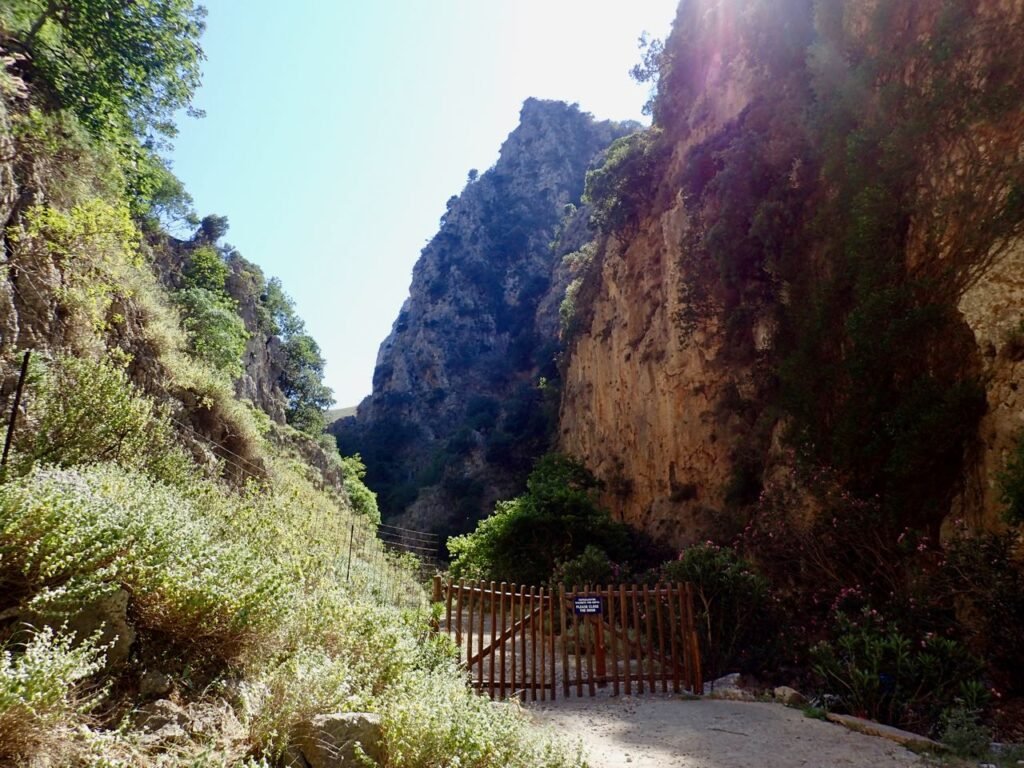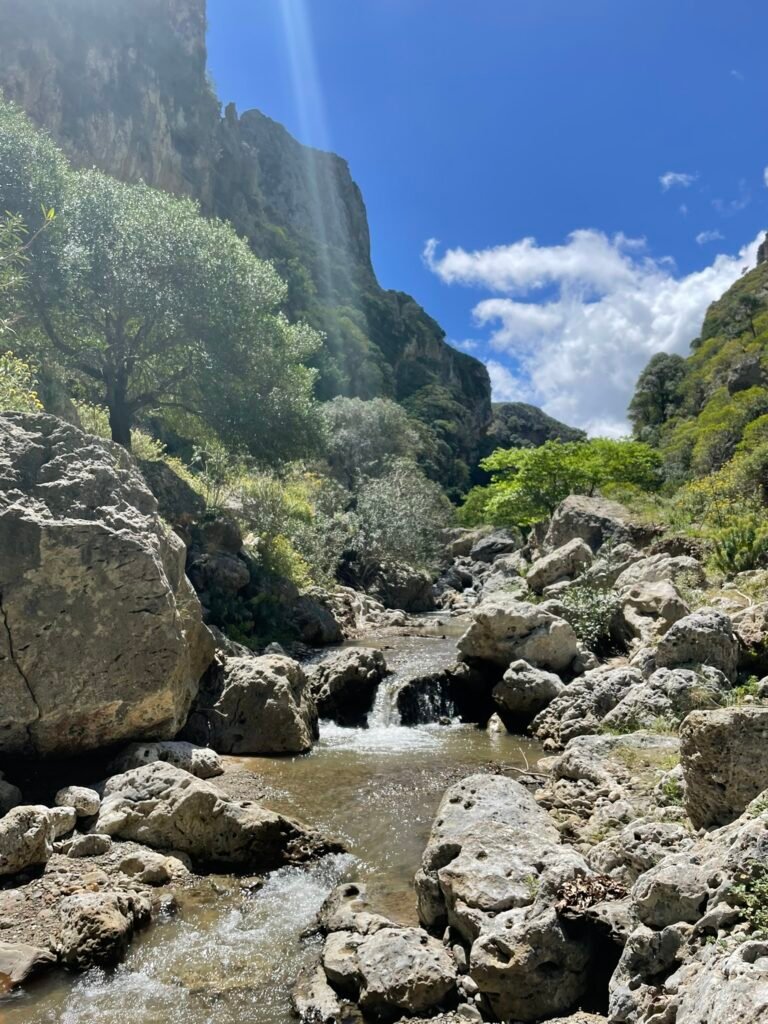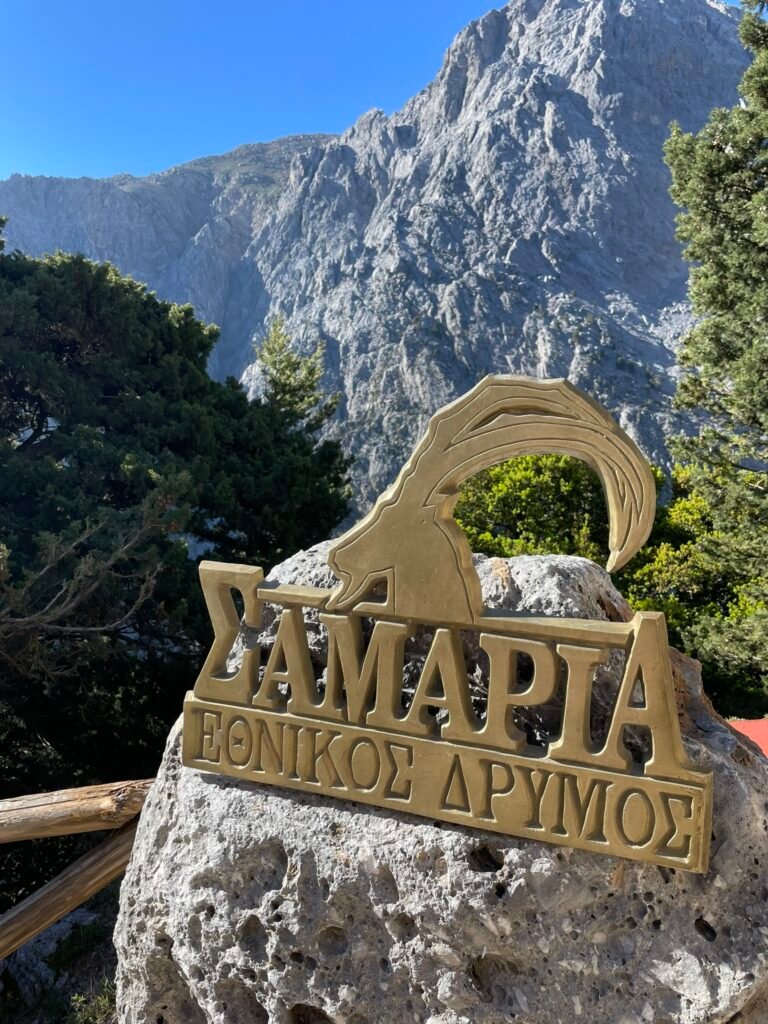Chania Gorges
Deliana Gorge
- Distance from Kolymvari 20km (35 mins by car)
- Distance from Chania 44km (1 hour by car)
Deliana Gorge (also known as Mesavlia Gorge) is a stunning yet peaceful natural spot in northwest Crete, near the villages of Deliana and Mesavlia, with road access from either village. The gorge is actually part of the Natura 2000 protected network.
The hike is a 4–6 km out-and-back trail, typically taking 2 to 3 hours depending on your pace and how many photo breaks you take. The terrain is mostly a well-defined gravel/dirt road, easily accessible for beginners and families with children with rewarding wildlife and nature views.
Some optional endpoints include a small mountain chapel along the gorge or continuing to Mesavlia village. Parking, a fountain, toilet facilities, and benches are available at the Deliana entrance
In the gorge you will find lush vegetation, including plane trees and oaks, especially vibrant in spring when the river water flow is stronger. As for the wildlife, keep an eye out for vultures (notably griffon or bearded vultures) soaring above, goats, and butterflies.
The flat, shady trail makes early morning, late afternoon, or springtime the ideal time to hike and avoid the heat. The gorge also offers flexible walking options with same day return without needing transport from the other end.
Combine the hike with a visit to the local tavernas in Deliana for authentic Cretan dishes.


Topoliano Gorge
- Distance from Kolymvari 22 km (30 mins by car)
- Distance from Chania 44 km (50 mins by car)
Topoliano gorge is located in western Crete with the main road to Elafonisi beach passing by it. The gorge stretches for about 1,5 km, beginning near Strovles village and ending at Topolia village.
A dramatic paved route winds through the steep canyon, flanked by sheer cliffs up to 300 m high giving you the opportunity to drive through the gorge.
The trail itself is rated easy to moderate with a 2/10 difficulty, and it takes about 1 to 1½ hours one-way or round-trip, depending on the pace. It includes narrow sections with bouldering, rocky terrain, with the highlight being the Agia Sophia Cave roughly at the midpoint, which can be accessed from the main road.
The scenery varies with towering limestone walls, streambeds that vary between 5–50 m wide, and dotted with holly, plane, oleander trees, and endemic flora.
Cave-dwelling species like the rare spider Pholcus creticus live here. Local lore tells of Minoan goddess Vritomartis, fairies, and Talos, who rested and listened to their lullabies.
If you choose to just drive by, you will come across a hand-carved one-lane, unlit tunnel (only 4 m wide) that cuts through the rock, dating back to WWII. Traffic is controlled by lights due to its narrowness. It usually takes 25–30 minutes to drive the gorge section; summer traffic can double the time, so starting early is recommended.
The best time to visit is in spring or autumn, when temperatures are mild, wildflowers are in bloom, and the gorge is less crowded. If you choose to visit at summer, do it with caution. Avoid hot summer afternoons; the dry winds and heat can make the experience uncomfortable.
Near the tunnel, vendors sell fresh honey, olives, traditional products, and fruit from small-scale Kissamos producers. The village of Topolia offers a variety of tavernas, where you can experience the authentic Cretan cuisine.
If your destination is Elafonisi Beach make sure to visit Chrysoskalitissa Monastery on your way there. It is one of the most significant monasteries of Crete with rich history.


Samaria Gorge
- Distance from Kolymvari 50 km (1 hour by car)
- Distance from Chania 42 km (1 hour by car)
Samaria Gorge is one of the most impressive natural landmarks in Crete, and one of the longest gorges in Europe (2nd longest). Located in the White Mountains range (Lefka Ori) in western Crete, it has been a National Park since 1962 and is a UNESCO Biosphere Reserve. The total distance of the gorge is about 16 km starting from Xyloskalo, all the way to the coastal village of Agia Roumeli. The main part inside the gorge is approximately 13 km, and the final stretch to the sea is 2–3 km. The elevation starts at around 1,230 meters and ends at sea level, so it’s a descent of over 1,200 meters. Most hikers complete it in 5–7 hours, depending on pace, fitness, and how many breaks you take. The reserve is open from May 1st to October 31st, if the weather permits it, since it closes in case of rain or strong winds. Entry is allowed from 7:00 AM to 1:00 PM (after 1 P.M you are only allowed to walk 2 km in).
What to Expect
Start as early as possible, at Xyloskalo, near the mountain village of Omalos. The trail begins with a steep descent, which can be challenging on the knees, especially with inappropriate footwear. The hike takes you through pine and cypress forests, riverbeds, and wooden bridges. The most famous spot is called the “Iron Gates” (Portes), the narrowest point in the gorge, where the walls close in to just 4 meters wide and 300 meters high. As for the flora and fauna, the park is home to over 450 plant species, many of which are endemic, and animals like the Cretan wild goat (kri-kri).
There are no shops or kiosks inside the gorge so make sure to carry plenty of water and snacks, although water is available at several spring points along the route. The trail ends in Agia Roumeli, a remote seaside village only accessible by boat or on foot. Great for a post-hike swim and meal.
Useful Hiking Tips:
- Start early (ideally by 7:00 AM) to avoid heat and crowds and to catch the last ferry (usually around 5:30 PM) from Agia Roumeli. This also gives you the time for lunch at one of the taverns of the village and a quick dip in the crystal clear waters.
- Wear hiking shoes with a good grip, considering that the initial part is rocky and steep.
- Bring lightweight clothing, a jacket for the morning, a hat, sunglasses, sunscreen, snacks, and at least 1.5 L of water.
Transportation:
Start point: Drive or take a bus from Chania to Xyloskalo (about 1.5 hours).
End point: After reaching Agia Roumeli, take the ferry to Sougia or Sfakia, then a bus/taxi back to Chania.
Why It’s Worth It:
The dramatic landscape and narrow passage between cliffs is an unforgettable sight. You’ll also pass through protected ecosystems and witness wild Crete at its best.
Furthermore, it’s a unique hike from mountains to sea. You descend from alpine scenery to a beach in one continuous walk, experiencing everything Crete has to offer all at once.
And finally, finishing your hike with a swim in the Libyan Sea and a meal in a car-free village is a truly rewarding ending.


